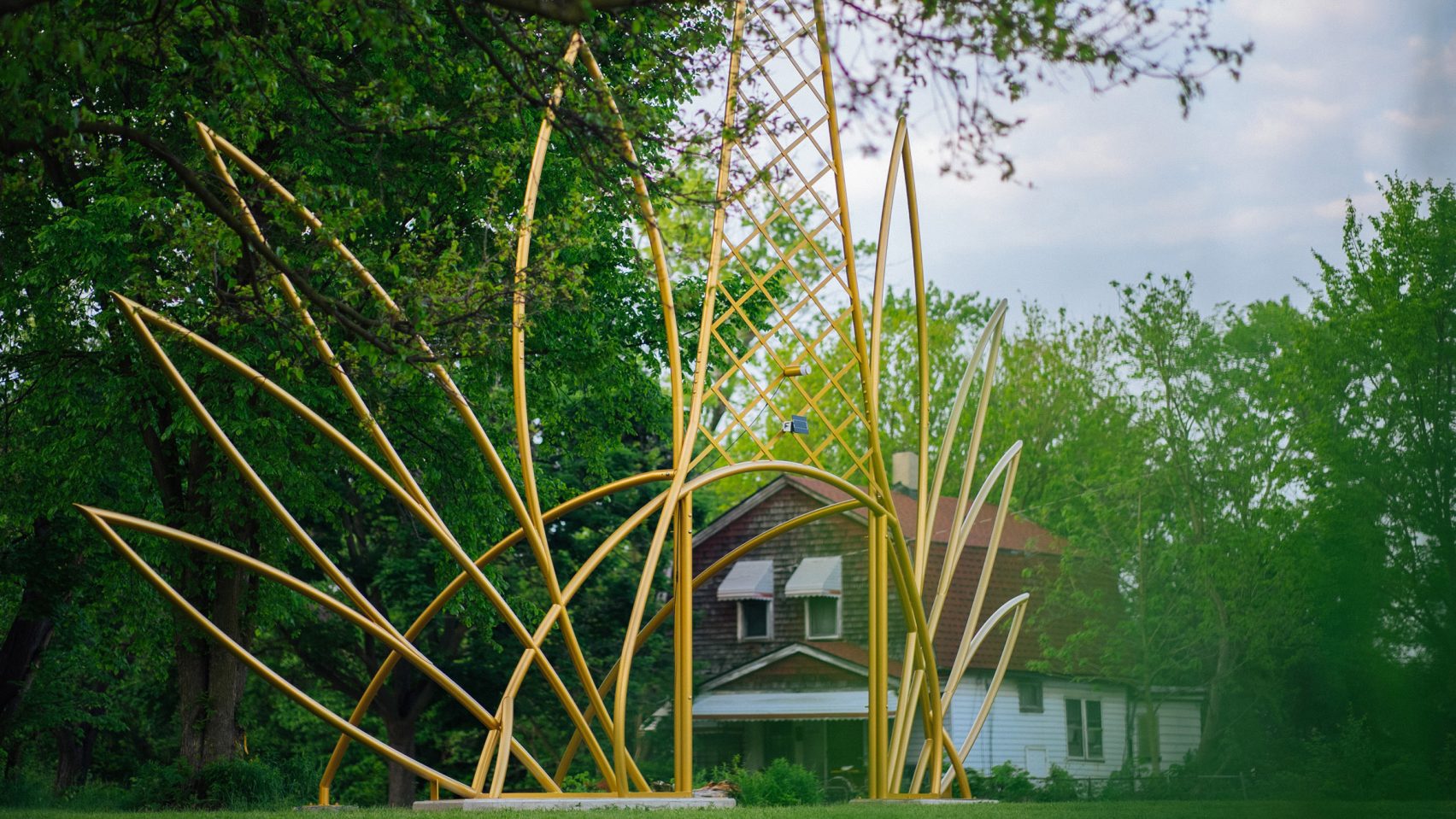Jordan Weber creates installation that monitors Detroit’s air quality

New York Artist Creates Regenerative Sculpture to Monitor Air Pollution in Detroit
Artist Jordan Weber has unveiled a public “regenerative sculpture” in Detroit as part of a project to combat the effects of discriminatory urban planning. The installation, called New Forest, Ancient Thrones, takes the shape of two crowns worn by African queens and serves as a monitoring system for air quality in the surrounding neighborhood. The sculpture is supported by local organizations Sidewalk Detroit and Canfield Consortium and is part of the ongoing Detroit Remediation Forest project by Weber.
Monitoring Air Quality and Landscaping Progress
The sculpture, made of gold-painted aluminum rods, features a sensor system that indicates the level of air pollution in the area. It also tracks the progress of landscaping efforts aimed at mitigating air pollution. LED lights attached to the sculpture display the quality of air using the US Environmental Protection Agency’s color system, ranging from good to hazardous. The data collected can be accessed through the JustAir phone app.
Addressing Health Effects and Environmental Injustice
Weber’s project aims to draw attention to the health effects of poor air quality and urban development on local communities, particularly low-income individuals and people of color. The expansion of the nearby automotive Stellantis-Mack Assembly Plant has resulted in increased asthma rates and displacement in the neighborhood due to the release of harmful pollutants into the atmosphere. Weber’s sculpture serves as a visual representation of these issues and promotes environmental justice education and quantitative change.
Future Plans for the Project
The Detroit Remediation Forest project will continue with the planting of pine and cypress trees to further mitigate air pollution. Additionally, an elevated walkway for “forest bathing” is planned for the future. Phase two of the project is scheduled for 2025.
Impact of Development in Detroit
Detroit has experienced significant development in recent years, with various projects focused on restoring dilapidated buildings and revitalizing the city. The involvement of arts and corporate institutions, such as the restoration of a historic train terminal for Ford and the conversion of an industrial bakery building into an arts center, highlights the city’s ongoing transformation.
The photography is by Noah Elliott Morrison unless otherwise stated.
SDGs, Targets, and Indicators
1. Which SDGs are addressed or connected to the issues highlighted in the article?
- SDG 3: Good Health and Well-being
- SDG 11: Sustainable Cities and Communities
- SDG 13: Climate Action
2. What specific targets under those SDGs can be identified based on the article’s content?
- SDG 3.9: By 2030, substantially reduce the number of deaths and illnesses from hazardous chemicals and air, water, and soil pollution and contamination.
- SDG 11.7: By 2030, provide universal access to safe, inclusive, and accessible, green, and public spaces, particularly for women and children, older persons, and persons with disabilities.
- SDG 13.1: Strengthen resilience and adaptive capacity to climate-related hazards and natural disasters in all countries.
3. Are there any indicators mentioned or implied in the article that can be used to measure progress towards the identified targets?
- Indicator for SDG 3.9: Monitoring system and LED lights affixed to the sculpture indicate the level of harmful air pollutants (particulate matter) surrounding the structure.
- Indicator for SDG 11.7: The sculpture serves as a gateway to a public park and is part of a larger project aimed at rehabilitating the surrounding land.
- Indicator for SDG 13.1: The sculpture is designed to track the progress of surrounding landscaping in mitigating air pollution.
SDGs, Targets, and Indicators Table
| SDGs | Targets | Indicators |
|---|---|---|
| SDG 3: Good Health and Well-being | 3.9: By 2030, substantially reduce the number of deaths and illnesses from hazardous chemicals and air, water, and soil pollution and contamination. | Monitoring system and LED lights affixed to the sculpture indicate the level of harmful air pollutants (particulate matter) surrounding the structure. |
| SDG 11: Sustainable Cities and Communities | 11.7: By 2030, provide universal access to safe, inclusive, and accessible, green, and public spaces, particularly for women and children, older persons, and persons with disabilities. | The sculpture serves as a gateway to a public park and is part of a larger project aimed at rehabilitating the surrounding land. |
| SDG 13: Climate Action | 13.1: Strengthen resilience and adaptive capacity to climate-related hazards and natural disasters in all countries. | The sculpture is designed to track the progress of surrounding landscaping in mitigating air pollution. |
Copyright: Dive into this article, curated with care by SDG Investors Inc. Our advanced AI technology searches through vast amounts of data to spotlight how we are all moving forward with the Sustainable Development Goals. While we own the rights to this content, we invite you to share it to help spread knowledge and spark action on the SDGs.
Fuente: dezeen.com

Join us, as fellow seekers of change, on a transformative journey at https://sdgtalks.ai/welcome, where you can become a member and actively contribute to shaping a brighter future.







